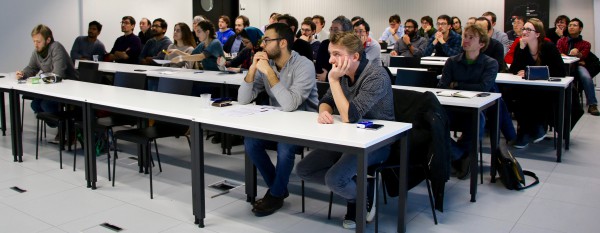MARVEL Junior Seminar — November 2019
The MARVEL Junior Seminars aim to intensify interactions between the MARVEL Junior scientists belonging to different research groups located at EPFL. The EPFL community interested in MARVEL research topics is very welcome to attend. We believe that these events will be central for establishing a vibrant community.
Each seminar consists of two presentations of 25 minutes each, allowing to present on a scientific question in depth, followed by time for discussion. The discussion is facilitated and timed by the chair.
Pizza is served at 11:45 in the MED hall (floor 0), and after the seminar at 13:30 you are cordially invited for coffee and dessert to continue discussion with the speakers.

MARVEL Junior Seminar Organizing Committee — Giuliana Materzanini, Stefano Falletta, Olga Syzgantseva, Maria Fumanal, Markus Stricker, Kristians Cernevics, Max Veit and Patrick Mayor
Abstract — Machine learning a Neural Network Magnesium potential
Markus Stricker1, Binglun Yin1, Eleanor Mak1, Rasool Ahmad1, Giulio Imbalzano2, Michele Ceriotti2, Willam A. Curtin1
1 Laboratory for Multiscale Mechanics Modeling (LAMMM), EPFL
2 Laboratory for Computational Science and Modeling (COSMO), EPFL
Magnesium is a desirable lightweight structural material but lacks the ductility needed for fabrication and performance. To overcome its limitations, the strongly anisotropic and complex dislocation plasticity in Magnesium and its alloys must be understood. This requires interatomic potentials that capture a wide range of subtle properties including small differences in various dislocation energies. While a very good MEAM-type potential exists for pure Mg, its transferability to alloys has been insufficient to date. Here, we thus first pursue development of a machine learning potential for pure Mg. We use a neural network (NN) framework with the Behler-Parrinello symmetry functions to describe atomic environments, with training data obtained from extensive first-principles DFT calculations on metallurgically-relevant properties. We first limit the training data to the same set of data used to fit the MEAM potential and thus study the ability of the NN potential to achieve results comparable to the MEAM potential for equal inputs. We demonstrate broad success of the NN potential, as compared to the MEAM potential. Subsequently we include further data in the training and discuss aspects of the NN potential that might be improvable, and discuss extensions of the general approach to the important Mg-Y alloy.
Abstract — Band Edge Alignment at NiO/H2O and Ni2P/H2O Interfaces
Stefano Falletta1, Patrick Gono1, Zhendong Guo1, Stavroula Kampouri2, Kyriakos C. Stylianou2, Alfredo Pasquarello1
1 Chair of Atomic Scale Simulation (CSEA), EPFL
2 Laboratory of Molecular Simulation (LSMO), EPFL
We compute the band edges of NiO and Ni2P with respect to the standard hydrogen electrode redox level. The valence band and conduction band edges of the semiconductor are calculated by performing electronic structure calculations at the hybrid functional level. For the semiconductor/water interface, we consider both a molecular and a dissociative model of the water adsorbed at the semiconductor surface. By performing ab-initio molecular dynamics simulations, we identify the most stable interface model and ultimately determine the band edge alignment. We find that both NiO and Ni2P show a favorable band edge alignment for the H2 evolution reaction, while only NiO can promote the O2 evolution reaction. Finally, we give an explanation for the role of NiO and Ni2P as co-catalysts for the metal organic framework MIL-125-NH2, used as photo-catalyst.
Check the list of the next MARVEL Junior Seminars here.
Low-volume newsletters, targeted to the scientific and industrial communities.
Subscribe to our newsletter